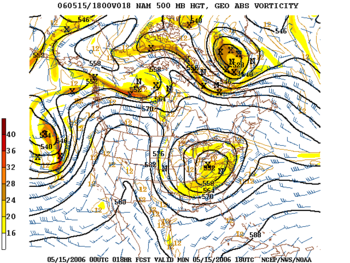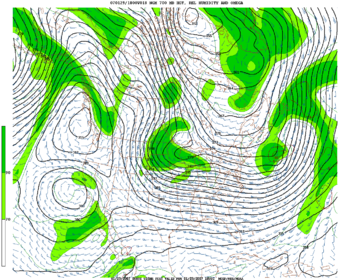- Block (meteorology)
-
An example of an omega block over western North America in May 2006

Blocks in meteorology are large scale patterns in the atmospheric pressure field that are nearly stationary, effectively "blocking" or redirecting migratory cyclones. They are also known as blocking highs or blocking anticyclones.[1] These blocks can remain in place for several days or even weeks, causing the areas affected by them to have the same kind of weather for an extended period of time (e.g.- precipitation for some areas, clear skies for others).[2] In the Northern Hemisphere, extended blocking occurs most frequently in the spring over the eastern Pacific and Atlantic oceans.[1]
Similarly in northern Europe anticyclonic blocks over western Russia and Scandinavia during the winter months can bring sub-zero easterly winds on their southern flanks, sometimes extending into the Atlantic ocean and forcing the prevailing jetstream as far south as Portugal and Spain. Northern and Western European severe winters such as 1683-4, 1739-40, 1795, 1895, 1940, 1947, 1962-63, 1978-79, 1986, 2009-10 and December 2010 are caused by such blocks. Blocking highs were a key feature of the extreme winter droughts in south-eastern Australia in 2006 [3]
Contents
Omega blocks
Omega blocks are so-named because the height fields associated with them resemble an Ω, the uppercase Greek letter omega. The typical pattern for this is low-high-low, arranged in the west-east direction.[2]
Rex blocks
An example of a rex block off the coast of North America in January 2007
Rex blocks consist of a high situated to the north of a low. Very often both the high and the low are closed, meaning that the isobars (or constant geopotential height lines) defining the high/low close to form a circle.[4] Rex blocks are not so-named because they are considered the "king of blocks", although the depiction of air flow around rex blocks on upper-air charts often resembles the mouth of a tyrannosaurus rex. Rather they were named after the meteorologist who first identified them.[5]
Cut-off highs and lows
When an upper level high or low pressure system becomes stuck in place due to a lack of steering currents, it is known as being "cut off". The usual pattern which leads to this is the jet stream retreating to the north, leaving the then cut off system behind.[6] Whether or not the system is of high or low pressure variety dictates the weather that the block causes. Precisely this situation occurred over the southwestern United States in late spring and early summer of 2007, when a cut off low system hovering over the region brought unusually cool temperatures and an extraordinary amount of rain to Texas and Oklahoma (see June 2007 Texas flooding).
If the block is a high, it will usually lead to dry, warm weather as the air beneath it is compressed and warmed; and rainy, cooler weather if the block is a low.[6]
See also
References
- ^ a b Glossary of Meteorology, Second Edition; American Meteorlogical Society, 2000; ISBN 1-878220-34-9.
- ^ a b Brief page about Omega blocks
- ^ [1] see p116
- ^ Brief page about Rex blocks
- ^ Another Rex Block page
- ^ a b Atmospheric Blocking
Categories:- Anticyclones
Wikimedia Foundation. 2010.


